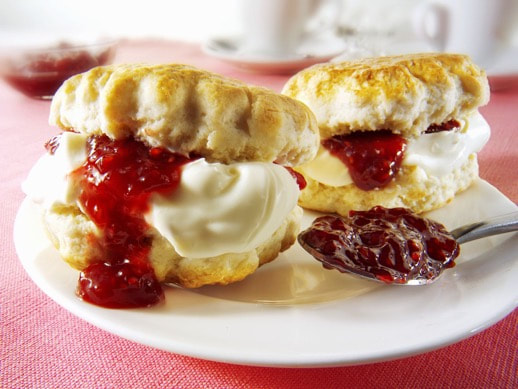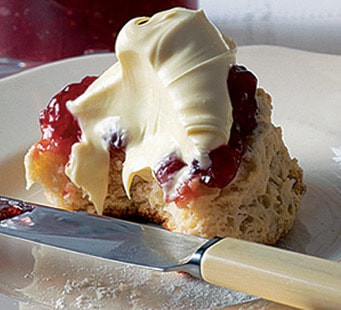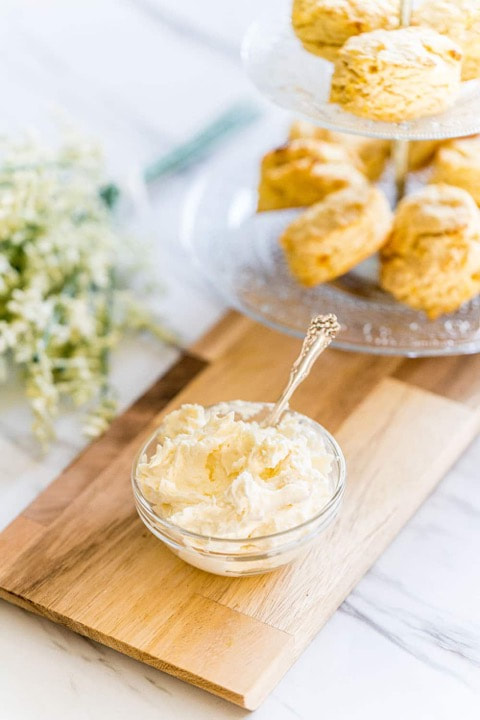In Devon, your cream will be called Devonshire clotted cream, but if you are in or near Cornwall, you will be served Cornish clotted cream. It’s a little bit like California cheese versus Wisconsin cheese, both high quality and delicious but maybe tasting slightly different due to what the cows are eating in their locale. To further complicate matters, there is no American equivalent to British “double cream” which is 48% butterfat. Our standard butterfat content for heavy cream is 36% to 38%.
However, American cream can be successfully made into clotted cream. For a large tea party this spring, I set out learning to make real clotted cream. For my experiments, I used either pints of Trader Joe’s organic, pasteurized, heavy whipping cream or the half gallon cartons of Producer’s Dairy pasteurized, heavy whipping cream available at Costco.
I specify the various attributes of these creams because they factor into the texture and quantity of the clotted cream. After reading many, many recipes for homemade clotted cream, I would say 95% of the recipes call for cream that is pasteurized and NOT ultra-pasteurized. Ultra-pasteurized cream has been heated to 280 degrees then chilled while pasteurized cream has been heated to 167 degrees before being chilled. (The ultra-pasteurization gives the cream a longer shelf life, up to 60 days, unopened.) As is the case with yogurt-making and cheese-making, the temperature has a dramatic effect on the structure of the milk proteins. Unlike yogurt or cheese, clotted cream is simply heated cream, without any added cultures.
Making clotted cream is a matter of heating and cooling liquid cream until it separates and thickens. Nothing is added to the cream but time and temperature. Though sounding straightforward, getting cream to clot to a particular thickness is a subtle process without obvious signposts. My first experiment produced a small amount of clotted cream and a lot of grayish liquid under the layer of cream. My second batch was overheated, making the cream look slightly browned in spots, totally unacceptable; I was looking for a creamy yellowish color without a hint of browning.
These first batches were done in two different ovens, both set to 180 degrees. As bakers know firsthand, all ovens are slightly different. I used 4 cups of cream, poured into a glass baking pan, 8” by 8” square. Several recipes mentioned the depth of the cream as well as the amount of cream, usually at least 1” deep but no more than 2” deep. My 4 cups of cream measured about 1.25” deep.
After these first two unsatisfactory batches, I read more recipes for clotted cream, one of which mentioned making it in a slow cooker. That seemed perfect. A slow cooker delivers even heat and can be set for the requisite 12 hours. I borrowed Suzi’s slow cooker and set it on the “Warm” setting for 12 hours. The next step is to cool the heated cream, so I lifted the crock out of the slow cooker and let it cool for an hour or so. I carefully put a spoon under the top layer and peeked underneath. The cream layer seemed very thin, but I covered it and put it in the refrigerator to finish setting. It turns out that this step is really important and cannot be rushed. It needs to chill at least 12 hours. At this point, I cautiously spooned the thick top off the more watery layer underneath. It only made approximately a cup of clotted cream which seemed shockingly little from the four cups I started with. And what do you do with all the unclotted cream? Various recipes suggested using the leftover liquid in scones, breads, or less appealingly, in your tea or coffee.
After three batches of only slightly satisfactory clotted cream, I was feeling a bit hopeless and thought about abandoning the project. The reason I didn’t give up is that though all three batches weren’t perfect in amount or texture, all tasted absolutely divine. The taste is almost indescribable, naturally sweeter than cream, without being at all cloying, subtly nutty in aftertaste, and wonderfully sticky and delicious, in a way different from crème fraiche, mascarpone, or whipped cream. And so much better than the small jars of Devonshire cream imported from Britain which taste overcooked.
I did take a few days off and continued to read more clotted cream recipes and blog posts. I compared, step by step, the way I handled the cream as compared to the way each recipe writer recommended handling the cream. I’d done the heating method, the cooking time, the cooling time, and the spooning into glass jars just the way they showed. What was I missing?
With a slow cooker borrowed this time from Peggy Sue, I began again with my 4 cups of cream. Twelve hours of cooking, twelve hours of chilling. When the time came, I carefully spooned the clotted top layer into a glass bowl. Under the thickened layer was a creamy layer that was thicker than uncooked cream but not as thick as the clotted part. I tentatively scooped a little of this aside to reveal the grayish liquid I’d seen in my first batch. I definitely didn’t want the grayish stuff,but the thickish cream seemed useful. As this batch of clotted cream was relatively thick, I stirred some of the cream into it, remembering that a few of the recipes had mentioned stirring it up before chilling. Aha! That was the final key point: the clotted cream could absorb some of the additional cream without becoming too thin. I stirred in most of the extra cream and set it to chill for another day. Voila, perfect clotted cream, and quite a bit of it, as well.
When we served my now perfected clotted cream at our Cherry Berry Tea, on a warm day in June, I noticed that as it sat out, it became yellower and firmer, in texture more like whipped cream cheese. The mysteries of time, temperature, and butterfat are truly unending.
4 cups pasteurized cream
Slow cooker with removable crock, shallow spoon, glass jar or bowl
Begin several days before you wish to serve the clotted cream.
- Pour cream into slow cooker, cover with lid. Set on “Warm” and cook for 12 hours.
- Remove crock and let cool on counter for about 1 hour.
- Cover crock and chill for 12 hours.
- Carefully spoon thickened layer into glass bowl. Stir in some of the thinner creamy layer, while avoiding the grayish liquid at the bottom.
- Chill for 12 to 24 hours. Serve with scones and jam. The clotted cream keeps, chilled and covered, for up to a week.




 RSS Feed
RSS Feed